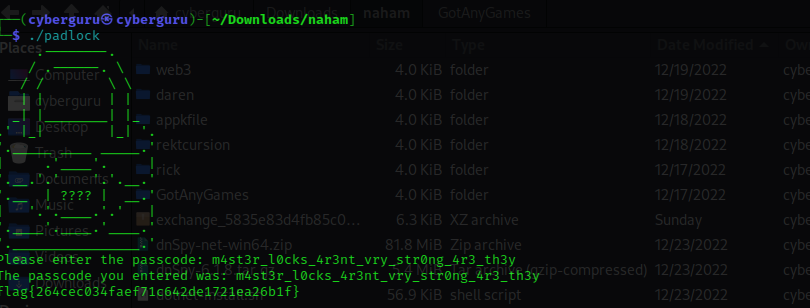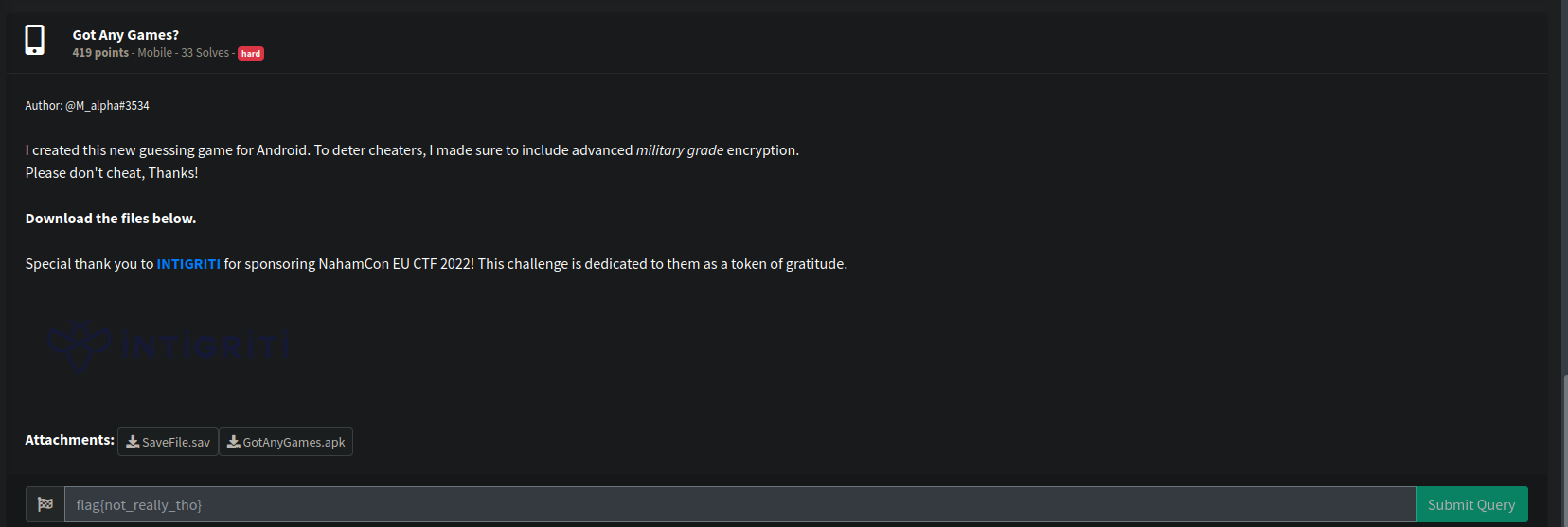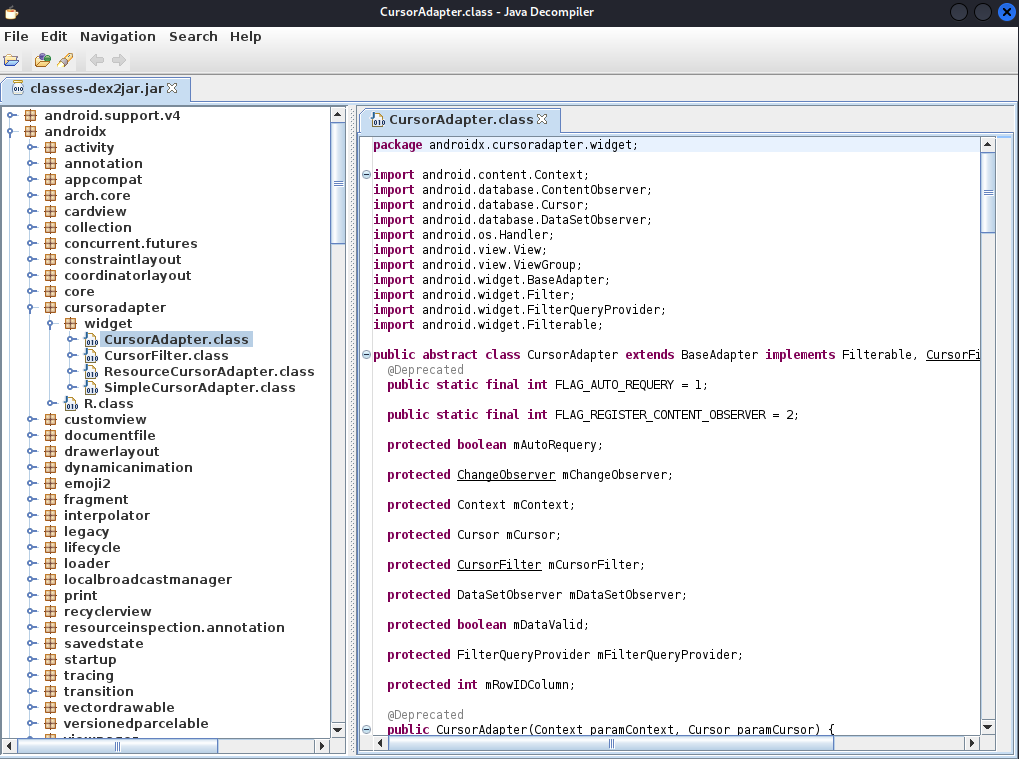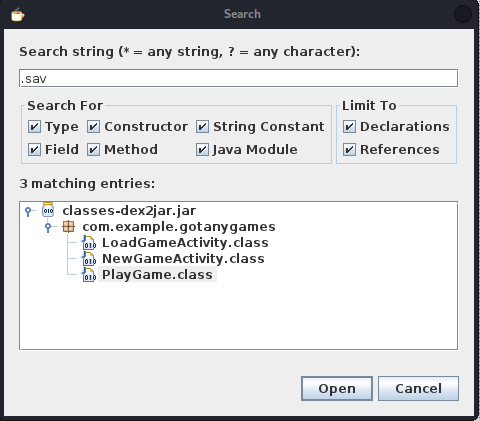1. Padlock (Rev)

This is the first and easy reverse engineering challenge, running the file we have a prompt asking for key input
we could see that its asking for an input passcode, lets try decompiling it with binja we have the following disassembly;
commented assembly:
main:
00001538 f30f1efa nop edx, edi
0000153c 55 push rbp {__saved_rbp}
0000153d 4889e5 mov rbp, rsp {__saved_rbp}
00001540 4883ec40 sub rsp, 0x40
00001544 897dcc mov dword [rbp-0x34 {var_3c}], edi
00001547 488975c0 mov qword [rbp-0x40 {var_48}], rsi
0000154b 64488b0425280000…mov rax, qword [fs:0x28]
00001554 488945f8 mov qword [rbp-0x8 {var_10}], rax
00001558 31c0 xor eax, eax {0x0}
0000155a b93f000000 mov ecx, 0x3f
0000155f ba3f000000 mov edx, 0x3f
00001564 be3f000000 mov esi, 0x3f
00001569 bf3f000000 mov edi, 0x3f
0000156e e896fcffff call print_lock ; <-- print lock output
00001573 488d05930b0000 lea rax, [rel data_210d] {"Please enter the passcode: "} ; <-- ask for input text
0000157a 4889c7 mov rdi, rax {data_210d, "Please enter the passcode: "}
0000157d b800000000 mov eax, 0x0
00001582 e879fbffff call printf; <--- sent to stdout with printf
00001587 488b05822a0000 mov rax, qword [rel stdin]
0000158e 488d55d0 lea rdx, [rbp-0x30 {var_38}]
00001592 488d0d900b0000 lea rcx, [rel data_2129]
00001599 4889ce mov rsi, rcx {data_2129}
0000159c 4889c7 mov rdi, rax
0000159f b800000000 mov eax, 0x0
000015a4 e817fbffff call __isoc99_fscanf ; <---input collected and stored
000015a9 488d45d0 lea rax, [rbp-0x30 {var_38}]
000015ad 4889c6 mov rsi, rax {var_38}
000015b0 488d05790b0000 lea rax, [rel data_2130] {"The passcode you entered was: %s…"}
000015b7 4889c7 mov rdi, rax {data_2130, "The passcode you entered was: %s…"}
000015ba b800000000 mov eax, 0x0
000015bf e83cfbffff call printf ; <-- give back our input
000015c4 488d45d0 lea rax, [rbp-0x30 {var_38}]
000015c8 ba65000000 mov edx, 0x65 ; <-- load 'e' into edx>
000015cd be33000000 mov esi, 0x33 ; <-- load '3' into esi>
000015d2 4889c7 mov rdi, rax {var_38} ; <-- load our input into rdi>
000015d5 e8f2feffff call replace; <-- call some replace function to replace '3' with 'e' in the input
000015da 488d45d0 lea rax, [rbp-0x30 {var_38}]
000015de ba20000000 mov edx, 0x20
000015e3 be5f000000 mov esi, 0x5f
000015e8 4889c7 mov rdi, rax {var_38}
000015eb e8dcfeffff call replace
000015f0 488d45d0 lea rax, [rbp-0x30 {var_38}]
000015f4 ba6f000000 mov edx, 0x6f
000015f9 be30000000 mov esi, 0x30
000015fe 4889c7 mov rdi, rax {var_38}
00001601 e8c6feffff call replace
00001606 488d45d0 lea rax, [rbp-0x30 {var_38}]
0000160a ba61000000 mov edx, 0x61
0000160f be34000000 mov esi, 0x34
00001614 4889c7 mov rdi, rax {var_38}
00001617 e8b0feffff call replace
0000161c 488d45d0 lea rax, [rbp-0x30 {var_38}]
00001620 4889c7 mov rdi, rax {var_38}
00001623 e8b8faffff call strlen ; <-- check the procesed input len>
00001628 4883f826 cmp rax, 0x26 ; <-- compare with size of 38 >
0000162c 0f8580000000 jne 0x16b2
As we could see from the main function, our input is collected from stdin and sent as arguments to replace function then, the replace function replaces any leet variables with their normal alphabet character such as ‘3’ with ‘e’, ‘4’ with ‘a’, ‘0’ with ‘o’ and so on after that the length of our input is compared with 0x26 {that’s 38 in decimal}.
00001632 488d45d0 lea rax, [rbp-0x30 {var_38}]
00001636 4889c6 mov rsi, rax {var_38}
00001639 488d05180b0000 lea rax, [rel data_2158] {"master locks arent vry strong ar…"}
00001640 4889c7 mov rdi, rax {data_2158, "master locks arent vry strong ar…"}
00001643 e8c8faffff call strcmp
00001648 85c0 test eax, eax
0000164a 757a jne 0x16c6
after that, it goes on to compare the processed input with the string “master locks arent vry strong are they” to solve it we simply reverse the comparision string according to the assembly flow doing that we have the flag

flag{264cec034faef71c642de1721ea26b1f}
2. Rick (rev)

This is the second reverse engineering challenge we were given two files a stripped elf 64-bit binary program and a encrypted cipher text, running the program we have this output

the program seems to be looking for a flag.txt file, lets decompile the program with ghidra
bool FUN_00101309(void)
{
int iVar1;
ulong uVar2;
void *__ptr;
bool bVar3;
DAT_00104050 = fopen("input.txt","rb");
bVar3 = DAT_00104050 != (FILE *)0x0;
if (bVar3) {
fseek(DAT_00104050,0,2);
uVar2 = ftell(DAT_00104050);
fseek(DAT_00104050,0,0);
__ptr = malloc((long)(int)uVar2);
fread(__ptr,(long)(int)uVar2,1,DAT_00104050);
fclose(DAT_00104050);
iVar1 = FUN_0010144b(__ptr,uVar2 & 0xffffffff);
DAT_00104020 = fopen("ct.enc","wb");
fwrite(DAT_00104028,(long)iVar1,1,DAT_00104020);
fclose(DAT_00104020);
}
else {
puts("Could not open flag.txt\n");
}
return bVar3;
}
analyzing the program we see that it opens an “input.txt” file and pass the content to FUN_0010144b then writes the output of the function to another file called “ct.enc”, if the “input.txt” file does not exist it prints out “could not open flag.txt” which is exactly our output in the first picture above
lests see the content of FUN_0010144b function
int FUN_0010144b(uchar *param_1,int param_2)
{
long in_FS_OFFSET;
int local_28;
int local_24;
EVP_CIPHER_CTX *local_20;
EVP_CIPHER *local_18;
long local_10;
local_10 = *(long *)(in_FS_OFFSET + 0x28);
local_28 = param_2;
memset(&DAT_00104040,0,0x10);
DAT_00104028 = (uchar *)malloc((long)param_2);
local_20 = EVP_CIPHER_CTX_new();
local_18 = EVP_aes_128_cbc();
FUN_00101539();
EVP_EncryptInit(local_20,local_18,&DAT_00104030,&DAT_00104040);
EVP_EncryptUpdate(local_20,DAT_00104028,&local_28,param_1,param_2);
EVP_EncryptFinal_ex(local_20,DAT_00104028 + local_28,&local_24);
if (local_10 != *(long *)(in_FS_OFFSET + 0x28)) {
/* WARNING: Subroutine does not return */
__stack_chk_fail();
}
return local_24 + local_28;
}
The function is an implementation of 128 AES_CBC cipher in c, which makes use of the EVP_CIPHER_CTX_new() library module,
as usuall with AES we need an IV and a kEY to encrypt a plaintext, analyzing the function we could see that the IV is a 16 byte of 0’s and the KEY is calculated by a function called FUN_00101539(void) which is then stored in a pointer called &DAT_00104030.
analyzing the content of the function we have:
void FUN_00101539(void)
{
uint local_10;
int local_c;
for (local_c = 0; local_c < 0x10; local_c = local_c + 1) {
if (local_c == 0) {
local_10 = 0x27e2;
}
else {
local_10 = (local_10 + local_c) * 4 ^ 0x29fa;
}
(&DAT_00104030)[local_c] = (char)local_10;
}
return;
}
the function simply creates a key of size 16 byte and stores it in DAT_0014030, so all our parameters of IV and KEY is available we could reimplement thesame function in c++ and decrypt the cipher text. full code here
int dec_func(unsigned char *ciphertext, int ciphertext_len, unsigned char *key, unsigned char *iv) {
EVP_CIPHER_CTX *ctx;
int len;
int plaintext_len;
unsigned char *plaintext;
// Allocate and initialize a new cipher context
ctx = EVP_CIPHER_CTX_new();
// Initialize the context for a decryption operation using the
// AES cipher in CBC mode with the given key and IV
EVP_DecryptInit(ctx, EVP_aes_128_cbc(), key, iv);
// Allocate a buffer to hold the plaintext
plaintext = (unsigned char*)malloc(ciphertext_len);
// Decrypt the ciphertext and store the resulting plaintext in the buffer
EVP_DecryptUpdate(ctx, plaintext, &len, ciphertext, ciphertext_len);
plaintext_len = len;
// Finalize the decryption operation
EVP_DecryptFinal_ex(ctx, plaintext + len, &len);
plaintext_len += len;
// Clean up the cipher context
EVP_CIPHER_CTX_free(ctx);
cout << plaintext;
return plaintext_len;
}
<---snip--->
compiling the program with g++ rick.cpp -lcrypto -lssl and running it we have our flag as:

flag{6265a883a2d001d4fe291277bb171bac}
3. Got Any Games? (Andriod)

This an andriod challenge, two files where given in the task, a SaveFile.sav file and GotAnyGames.apk file, according to the hint it says its a guessing game for andriod, which implements an advanced militrary grade encryption to deter cheaters.
opening the SaveFile.sav file, we saw some giberrish texts, probably some encrypted stuff

well its an andriod task time to use the apktool to decompile it, this are the content of the apk file

after decompiling it i converted the classes.dex file to classes.jar file using the dex2jar program

and finally we got our jar file we could load to java decompiler JD-GUI, i didn’t bother installing the apkfile on an andriod emulator just went on too decompile it and started searching around talk about being cozzy xd :)
these our classes file loaded in jd-gui

searching through and playing around, firsting i searached for was how the “SaveFile.sav” file was created, thereby narrowing my search to some class files, from the search result i saw the string “.sav” was mentioned in three classes

took each class one by one and analyze them,

so basically the PLayGame.class file loads up a file with an extension of “.sav” to read the contents which is then used to initialize the gamestate used for playing the guessing game and also save the gamestate with same extension
private final byte[] encryptSave(String paramString) {
Cipher cipher = Cipher.getInstance("AES/CBC/PKCS7Padding");
cipher.init(1, new SecretKeySpec(this.k, 0, 32, "AES"));
byte[] arrayOfByte1 = paramString.getBytes(Charsets.UTF_8);
Intrinsics.checkNotNullExpressionValue(arrayOfByte1, "this as java.lang.String).getBytes(charset)");
arrayOfByte1 = cipher.doFinal(arrayOfByte1);
Mac mac = Mac.getInstance("HmacSHA256");
mac.init(new SecretKeySpec(this.k, 0, 32, "HmacSHA256"));
byte[] arrayOfByte3 = cipher.getIV();
Intrinsics.checkNotNullExpressionValue(arrayOfByte3, "cipher.iv");
Intrinsics.checkNotNullExpressionValue(arrayOfByte1, "encryptedData");
arrayOfByte3 = mac.doFinal(ArraysKt.plus(arrayOfByte3, arrayOfByte1));
byte[] arrayOfByte2 = cipher.getIV();
Intrinsics.checkNotNullExpressionValue(arrayOfByte2, "cipher.iv");
arrayOfByte1 = ArraysKt.plus(arrayOfByte2, arrayOfByte1);
Intrinsics.checkNotNullExpressionValue(arrayOfByte3, "macValue");
return ArraysKt.plus(arrayOfByte1, arrayOfByte3);
}
analyzing further we could see a call was made to a function called encryptSave that encrypts the gameState content into a file using the AES/CBC/PKCS7Padding mode, which uses a 32 bit IV and a KEY.
Finding the IV and KEY

a specific function is responsible in generating the key, reimplementing this function in python we got the key to be
[238,236,133,123,132,215,41,111,93,8,227,45,179,170,235,139,150,187,160,231,187,46,155,206,207,143,107,226,131,54,202,248]
Finding the IV

i realized that from the LoadGameActivity.class the class responsible for loading the gameState from the “.sav” file extension we could see that their is a function called String decrypt that uses the first 16 byte of the “.sav” file extension as our IV and the remainning as our cipher text this means that the IV and Cipher text was stored in the same file.
with all this information we could easily write a script to decrypt the “SaveFile.sav” in python full file here
from Crypto.Cipher import AES
values=[238,236,133,123,132,215,41,111,93,8,227,45,179,170,235,139,150,187,160,231,187,46,155,206,207,143,107,226,131,54,202,248]
key = bytearray(values)
with open('SaveFile.sav', 'rb') as f:
cipher = f.read()
iv = cipher[:16]
cipher = cipher[16:]
xcipher = AES.new(key, AES.MODE_CBC, iv)
mess = xcipher.decrypt(cipher)
print(mess)
running it we got our flag

flag{38002abd05c651c83e1d4c0177a8eaca}
4. Math_Smasher (scripting)
This is my most favourite challenge as it as to do with scripting, the main task of the challenge was to connect to a web link that as an image, the image contains a math question to be solved and a mini box were the solution should be submited, this a sample below

so i utilize a python module called pytesseract (it’s an OCR tool implemented in python ) and urllib to get the work done. This a sample code full code here, after some time we got our flag.
pytesseract.pytesseract.tesseract_cmd = r"/usr/bin/tesseract"
URL = "http://challenge.nahamcon.com:32522"
IMAGE = "/static/eqn.png"
URL_IMAGE = URL + "/" + IMAGE
FLAG_URL= URL + "/static/flag.png"
def readImageFromUrl():
data = requests.get(url=URL_IMAGE)
return data.content
def downloadFlag():
data = requests.get(url=FLAG_URL)
if data.status_code != 404:
with open("flag.png","wb") as f:
f.write(data.content)
def sendResult(result):
data ={"eqn_ans":str(result)}
response= requests.post(url=URL,data=data)
array = response.content.decode().split('<p class="count">')[-1]
count, others = array.split("</p>")
print("Count: " + str(count))
#verify if flag pop
if "display: none;" not in others:
downloadFlag()